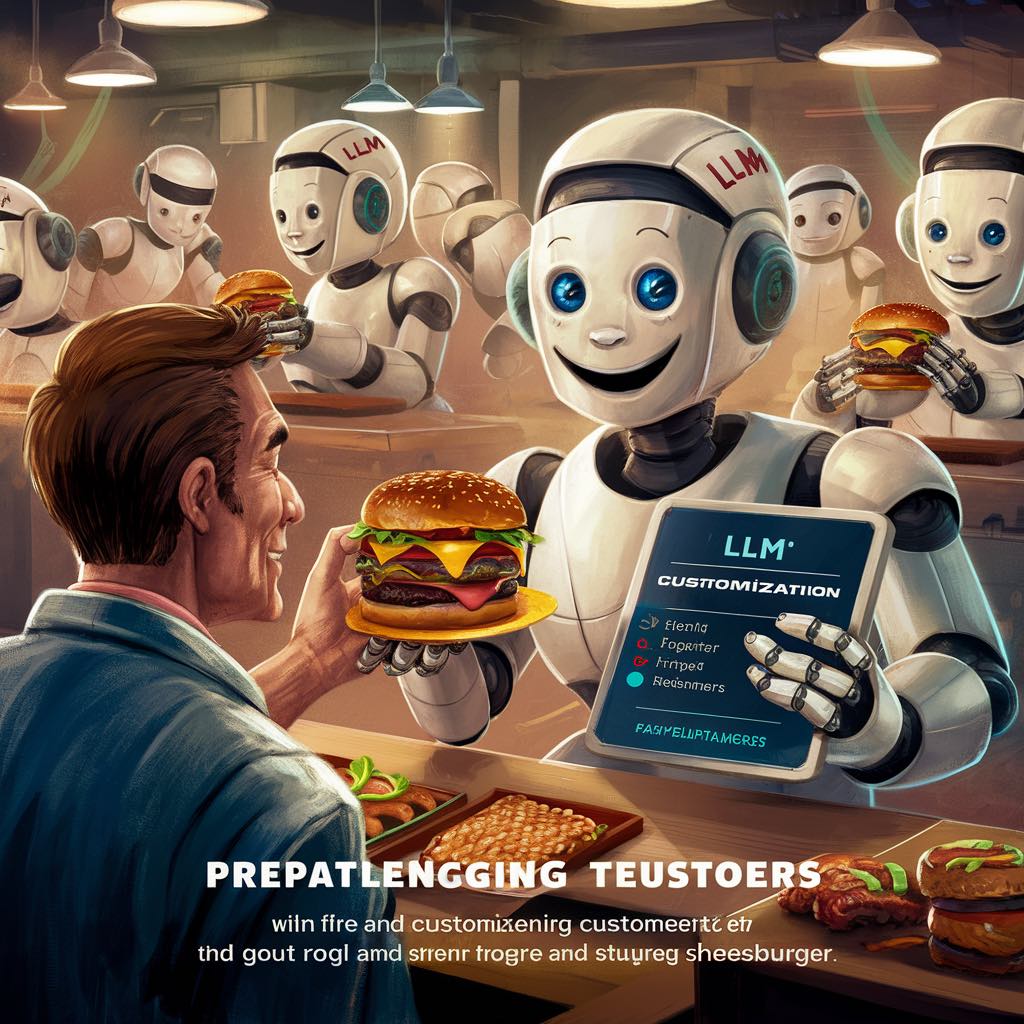Mastering the Art of ChatGPT: 15 Prompt Engineering Techniques
Journey through the fascinating world of Prompt Engineering, exploring 15 unique techniques that can transform how you interact with ChatGPT.
Join the DZone community and get the full member experience.
Join For FreeImagine you’re at your favorite burger place. You walk up to the counter and say, “Food, please!”
The server might give you anything from a salad to a fish sandwich — definitely not what you were craving.
But if you say, “I’d like a double cheeseburger with extra pickles and no onions,” you get exactly what you want, no surprises.
 This is precisely how it works with any Language Learning Model (LLM) for example, ChatGPT. The more specific and clear your request, the better the response you’ll get. If your prompt is vague or unclear, ChatGPT might serve up a response that’s not quite what you were hoping for. But if you give it a well-crafted prompt, you’ll get a precise and relevant answer.
This is precisely how it works with any Language Learning Model (LLM) for example, ChatGPT. The more specific and clear your request, the better the response you’ll get. If your prompt is vague or unclear, ChatGPT might serve up a response that’s not quite what you were hoping for. But if you give it a well-crafted prompt, you’ll get a precise and relevant answer.

Effective Prompt Engineering is like placing a perfect order at the burger joint. It ensures you get what you need quickly and accurately. Whether you’re asking for a simple fact, a detailed explanation, or a creative story, mastering the art of prompt crafting is key to optimizing ChatGPT’s responses. Just like you wouldn’t leave your burger order to chance, don’t leave your ChatGPT queries to chance either.
Be clear, be specific, and get exactly what you’re craving from ChatGPT!
In the same way, this article will explore different types of Prompt Engineering techniques and their applications.

1. Direct Prompts
- Definition: Simple and straightforward questions or commands.
- Effectiveness: Best for obtaining concise, factual information or direct answers.
- Example:
- Prompt: “What is the capital of France?”
- Response: “The capital of France is Paris.”
- Use case: Suitable for quick queries, fact-checking, and straightforward tasks.
2. Contextual Prompts
- Definition: Providing background information or context to guide the response.
- Effectiveness: Useful for more detailed and accurate answers, especially for complex topics.
- Example:
- Prompt: “Explain the process of photosynthesis as if you are teaching a high school student.”
- Response: “Photosynthesis is the process by which green plants use sunlight to make their own food…”
- Use case: Ideal for educational content, explanations, and detailed descriptions.
![role-playing]()
3. Role-Playing Prompts
- Definition: Assigning the AI a specific role or persona to generate more tailored responses.
- Effectiveness: Effective for creative writing, simulated conversations, and interactive scenarios.
- Example:
- Prompt: “You are a travel guide. Describe a day in Paris.”
- Response: “Welcome to Paris! Today, we’ll start with a visit to the Eiffel Tower, where you can…”
- Use case: Suitable for creative tasks, customer service simulations, and storytelling.
3. Step-By-Step Prompts
- Definition: Breaking down complex tasks into smaller, manageable steps for clarity.
- Effectiveness: Great for instructional content, problem-solving, and process explanations.
- Example:
- Prompt: “Explain how to bake a chocolate cake, step-by-step.”
- Response: “Step 1: Preheat your oven to 350°F. Step 2: Mix the dry ingredients…”
- Use case: Useful for tutorials, guides, and procedural content.
5. Conditional Prompts
- Definition: Using conditional statements to guide the response based on specific criteria.
- Effectiveness: Helps in generating responses tailored to different scenarios or conditions.
- Example:
- Prompt: “If I want to lose weight, what are some dietary changes I can make?”
- Response: “If you’re looking to lose weight, you might consider reducing your intake of sugary foods…”
- Use case: Ideal for personalized advice, decision-making processes, and scenario planning.
6. Iterative Prompts
- Definition: Refining the prompt through multiple iterations to improve response quality.
- Effectiveness: Effective for refining complex queries and improving response accuracy over iterations.
- Example:
- Initial Prompt: “Tell me about machine learning.”
- Refined Prompt: “Explain the basic principles of machine learning and its applications in healthcare.”
- Final Prompt: “Describe how machine learning algorithms can improve diagnostic accuracy in healthcare.”
- Use case: Best for in-depth research, iterative learning, and fine-tuning complex queries.
Advanced Prompting Techniques
7. One-Shot Learning Prompts
- Definition: Provide a single example to teach the model how to respond.
- Effectiveness: Useful for tasks where the model needs to learn from a single example.
- Example:
- Prompt: “Translate the following sentence to French: ‘Hello, how are you?’”
- Example: “Bonjour, comment ça va?”
- Task: “Translate ‘Good morning’ to French.”
- Response: “Bonjour.”
- Use case: Suitable for language translation, simple text transformations, and tasks requiring minimal examples.
8. Few-Shot (N-Shot) Learning Prompts
- Definition: Provide a few examples (n examples) to guide the model’s responses.
- Effectiveness: More effective than one-shot learning for complex tasks requiring additional context or examples.
- Example:
- Prompt: “Translate the following sentences to French:
- ‘Hello, how are you?’ — ‘Bonjour, comment ça va?’
- ‘Good morning’ — ‘Bonjour’ Task: Translate ‘Good night’ to French.”
- Response: “Bonne nuit.”
- Use case: Useful for nuanced tasks, more complex language translations, and generating patterns from multiple examples.
9. Zero-Shot Learning Prompts
- Definition: Asking the model to perform a task without providing an example.
- Effectiveness: Useful when examples are not available or for generalizing to unseen tasks.
- Example:
- Prompt: “What is the translation of ‘Good evening’ to French?”
- Response: “Bonsoir.”
- Use case: Suitable for general questions, broad tasks, and leveraging the model’s pre-trained knowledge.
10. Chain-Of-Thought Prompts
- Definition: Encouraging the model to explain its reasoning process step-by-step.
- Effectiveness: Enhances the model’s ability to handle complex reasoning and multi-step problems.
- Example:
- Prompt: “What will be the next number in the sequence 2, 4, 8, 16? Explain your reasoning.”
- Response: “The sequence is doubling each time. 2 doubled is 4, 4 doubled is 8, 8 doubled is 16. So, the next number should be 16 doubled, which is 32.”
- Use case: Suitable for problem-solving, logical reasoning, and educational content.
11. Self-Consistency Prompts
- Definition: Generating multiple responses for the same prompt and selecting the most consistent answer.
- Effectiveness: Improves the reliability of responses by averaging multiple outputs.
- Example:
- Prompt: “What is the capital of Japan?”
- Multiple responses: “Tokyo”, “Tokyo”, “Kyoto”.
- Final response: “Tokyo” (selected as the most consistent answer).
- Use case: Ideal for ensuring accurate answers in high-stakes situations, consistency checking, and validation.
12. Scratchpad Prompts
- Definition: Using a “scratchpad” to write down intermediate steps or thoughts before arriving at the final answer.
- Effectiveness: Enhances the ability to handle complex tasks by breaking them into smaller, manageable parts.
- Example:
- Prompt: “Solve 345 + 678. Show your work.”
- Scratchpad: “First, add the units: 5 + 8 = 13. Write down 3 and carry over 1. Next, add the tens: 4 + 7 + 1 = 12. Write down 2 and carry over 1. Finally, add the hundreds: 3 + 6 + 1 = 10. Write down 0 and carry over 1. The answer is 1023.”
- Use case: Useful for complex arithmetic, multi-step problem-solving, and detailed explanations.
13. Meta-Prompts
- Definition: Prompts that instruct the model on how to generate prompts or questions for further inquiry.
- Effectiveness: Useful for creating a framework for iterative questioning and deeper exploration.
- Example:
- Prompt: “Generate three questions that would help understand the impact of climate change on marine life.”
- Response: “1. How does rising sea temperature affect marine species diversity? 2. What are the consequences of ocean acidification on coral reefs? 3. How do changes in sea level influence coastal ecosystems?”
- Use case: Suitable for research, interview preparation, and exploratory tasks.
14. Prompt Chaining
- Definition: Combining multiple prompts in a sequence to build upon each response for a comprehensive output.
- Effectiveness: Enables complex workflows by linking responses together.
- Example:
- Prompt 1: “Describe the causes of global warming.”
- Response 1: “Global warming is primarily caused by the greenhouse effect, which results from the accumulation of greenhouse gases like carbon dioxide, methane, and nitrous oxide in the atmosphere.”
- Prompt 2: “What are the main sources of greenhouse gases?”
- Response 2: “The main sources include fossil fuel combustion, deforestation, industrial processes, and agricultural activities.”
- Prompt 3: “What are the effects of global warming on polar ice caps?”
- Response 3: “Global warming leads to the melting of polar ice caps, resulting in rising sea levels, loss of habitat for polar species, and changes in oceanic currents.”
- Use case: Useful for creating comprehensive narratives, multi-step processes, and detailed explanations.
15. AI Prompting/Automated Prompting
- Definition: Use AI-powered tools or ChatGPT itself to assist in crafting effective prompts based on the desired outcome.
- Effectiveness: Saves a lot of time and enhances accuracy by leveraging AI to generate optimal prompts for various scenarios, including image generation, content creation, and complex problem-solving.
- Example:
- Prompt: “Help me create a prompt to generate an image of a futuristic cityscape at sunset.”
- Response — AI-Generated Prompt: “Create an image of a futuristic cityscape at sunset, with towering skyscrapers, flying cars, and vibrant neon lights reflecting off glass buildings. The sky should be a blend of orange, pink, and purple hues.”
- Use case: This technique is particularly useful for generating complex scenarios, brainstorming creative ideas, and automating routine prompt creation tasks. For instance, it can be used in marketing to create detailed and engaging ad copy, in education to formulate comprehensive study guides, or in creative industries to outline detailed image or story scenarios.
Conclusion
We’ve journeyed through the fascinating world of Prompt Engineering, exploring 15 unique techniques that can transform how you interact with ChatGPT. From Direct Prompts for quick answers to AI prompts for automated, optimal queries, each method has its own flavor and utility.
The key takeaway here is that just like ordering your perfect burger, the way you craft your prompts can significantly impact the responses you get from ChatGPT. Whether you need a simple fact, a detailed guide, or a creative story, there’s a prompt engineering technique that’s just right for the job.
It’s essential to choose the right type of prompt based on what you need.
1. A direct question might be perfect for quick facts, while a contextual prompt could be better for detailed explanations.
2. Role-playing prompts can make interactions more engaging, and iterative prompts can help refine complex queries.
3. And let’s not forget the advanced techniques like few-shot learning or prompt chaining, which can take your interactions to the next level.
I encourage you to experiment with these different types of prompts. Play around with them, see what works best for your needs, and don’t be afraid to get creative. The more you practice, the better you’ll become at coaxing the perfect response from ChatGPT.
So, go ahead, dive in, and share your experiences with these Prompt Engineering techniques. Have you discovered a particularly effective prompt type? Or maybe you’ve created a unique prompt of your own? Let us know in the comments below. Let’s learn from each other and continue to optimize our interactions with ChatGPT together!
Important Note
- All images were generated using both DALL-E and Ideogram.
- Please be aware that the text and numbers within these images may not be accurate; however, the images effectively convey the intended message. Kindly disregard any inconsistencies.
References
- DataCamp. “A Beginner’s Guide to ChatGPT Prompt Engineering.” [Online]. Accessed: June 25, 2024.
- Unite.AI. “The Essential Guide to Prompt Engineering in ChatGPT.” [Online]. Accessed: June 25, 2024.
- PromptingGuide.ai. “ChatGPT Prompt Engineering.” [Online]. Accessed: June 25, 2024.
- DEV Community. “A Hands-on Guide to Prompt Engineering with ChatGPT and GPT-3.” [Online]. Accessed: June 25, 2024.
- Unite.AI. “OpenAI’s Prompt Engineering Guide: Mastering ChatGPT for Advanced Applications.” [Online]. Accessed: June 25, 2024.
Published at DZone with permission of Rakesh A Surendra. See the original article here.
Opinions expressed by DZone contributors are their own.


Comments